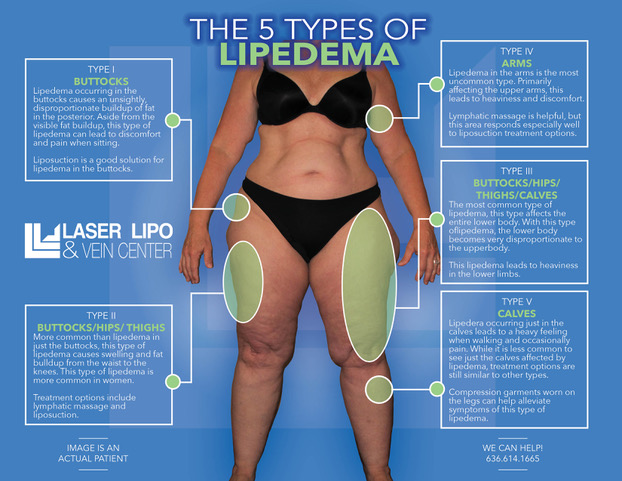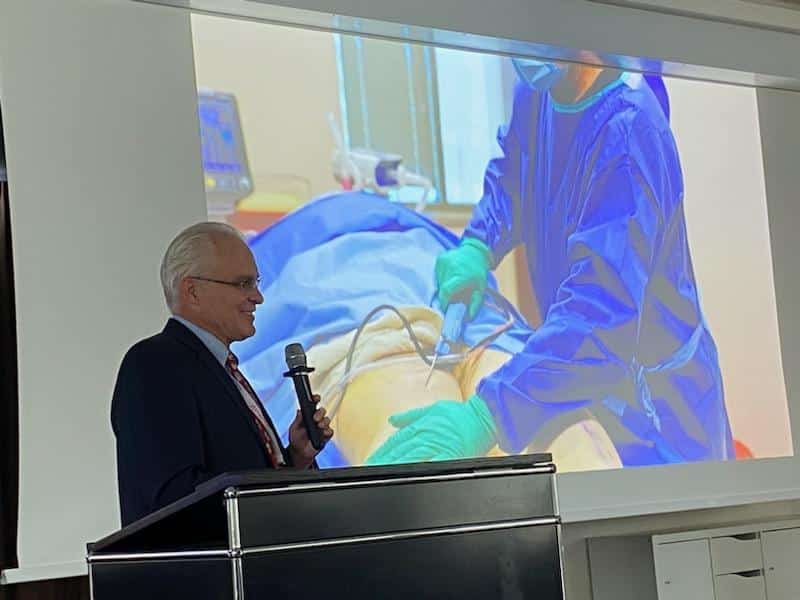Liposuction is a popular cosmetic procedure to remove excess fat and sculpt the body. It’s the most common cosmetic surgery, and 99% of the time, it’s done as an outpatient procedure. Modified liposuction surgery is the only available technique to correct and remove the abnormal adipose tissue of lipedema. Liposuction is a surgical treatment that involves the application of local (tumescent and water-assisted) anesthesia and subsequent removal of adipose tissue through a straw-like device called a cannula.4 One end of the cannula is connected to a vacuum device, and the other end is inserted through a small incision of the skin and removes fat via aspiration. Understanding the distinction between outpatient and inpatient liposuction surgery is important, as this can impact the recovery process and the level of care required. Below we will explore the differences between outpatient and inpatient liposuction surgery, the considerations that surgeons and anesthesiologists consider, and what patients can expect during their recovery.
What is Lipedema?
Lipedema is a condition that often goes undiagnosed or misdiagnosed due to its similarity to other conditions, such as obesity and lymphedema. It typically begins during or after puberty, pregnancy, or menopause, suggesting a hormonal influence on its development. Lipedema is characterized by an irregular distribution of fat beneath the skin, causing the affected areas to become larger than other body parts. The condition primarily affects the legs but can also involve the arms in some cases. Unlike obesity, lipedema does not respond to traditional weight loss methods, making it distinct from lifestyle-induced weight gain. Lipedema is also different from lymphedema as it does not start in the lower legs but affects the upper legs.

Is it Safer to Have Lipedema Liposuction Surgery in a Hospital?
No, most liposuction procedures are performed in an office or outpatient surgery center. For healthy people who do not have serious medical conditions, it is safer for them to have liposuction in an outpatient facility than in a hospital. Lipedema liposuction surgery in a hospital can expose patients to unnecessary germs and other pathogenic bacteria, as hospitals are breeding grounds for such due to the number of sick patients on broad-spectrum antibiotics, which leads to bacterial resistance. During the COVID-19 pandemic, it became clearer than ever that it is best to avoid going to a hospital unless you really need to.
Hospitals are where superbugs grow, and the chances of infection are much greater. It’s where people with highly contagious diseases like COVID and the Flu are treated, so it’s not a very safe place to go through a healing process.

Outpatient Lipedema Liposuction Surgery: Same-Day Treatment
Outpatient Lipedema liposuction surgery, or same-day or ambulatory surgery, refers to a procedure where patients undergo surgery and can then return home on the same day. This type of surgery is typically performed in office-based or ambulatory surgical facilities, and advancements in technology and anesthesia methods have allowed many surgeries to be performed as outpatient procedures.
The eligibility for outpatient liposuction surgery depends on various factors, including the type of procedure, the patient’s overall health, and the estimated fat volume to be removed. Surgeons and anesthesiologists carefully evaluate each patient to determine if they are suitable for same-day surgery or if hospitalization is required.
The length of the outpatient stay will vary based on the surgical procedure, the type of anesthesia used, and the patient’s medical history. After the surgery, patients are taken to the postanesthesia care unit (PACU) or a designated outpatient postoperative care area for monitoring. Patients may need to demonstrate certain tasks, such as drinking fluids and passing urine before discharge.
Before leaving the facility, patients receive detailed discharge instructions from the nursing staff. These instructions cover topics such as allowable activities, dietary restrictions, pain management, follow-up appointments, wound care, and any specific considerations related to the procedure. Patients must ask questions and fully understand how to care for themselves during recovery.
Inpatient Lipedema Liposuction Surgery: Overnight Hospitalization
In contrast to outpatient surgery, inpatient Lipedema liposuction surgery involves patients staying in the hospital for at least one night following the procedure. This type of surgery is usually recommended for more complex cases or when there is a need for extensive liposuction or combination procedures.
The decision to recommend inpatient surgery is based on the patient’s overall health, the areas of the body being treated, and the volume of fat to be removed. Certain procedures, such as breast reconstruction or extensive body contouring, may require overnight hospitalization due to the complexity and potential risks involved.
When undergoing inpatient liposuction surgery, patients should be prepared for an overnight stay in the hospital. Packing comfortable clothing to change into after the procedure and bringing any necessary items, such as crutches or a CPAP machine, is important. Patients should also bring important documents, such as Advance Directives or Power of Attorney if they have completed them.
Upon arrival in the hospital, patients meet with their assigned nurse, who will explain the room’s amenities and how to contact them if needed. The nurse will review the doctor’s orders, including medications, dietary restrictions, and activity limitations.
Liposuction Techniques and Cannulas
Liposuction for lipedema techniques vary, and the choice of technique depends on the individual patient’s needs and the surgeon’s expertise.
It’s common for some surgeons to advertise that they use the tumescent technique; however, in reality, they are using a similar technique that does not provide the benefits of local, tumescent anesthesia. In those cases, they use general anesthesia, which comes with an entirely different surgery and recovery plan.
Different types of anesthesia, cannulas (the instruments used to remove fat), and infiltrate solutions may be utilized. Here are some common liposuction for lipedema techniques:
- Dry Technique: This technique does not involve using an infiltrate solution. However, due to the associated blood loss, it is not recommended except in specific cases with a small fat volume to be removed.
- Wet Technique: The wet technique involves injecting 200-300 ccs of infiltrate solution into the surgical area. This solution may contain local anesthetic agents and additives to aid in the procedure.
- Superwet Technique: The superwet technique involves infusing 1 cc of infiltrate solution for each cc of fat to be removed. The infiltrate solution typically consists of saline or Ringer’s lactate with the addition of epinephrine and lidocaine.
- Tumescent Technique: The tumescent technique involves infusing a larger volume of infiltrate solution (3-4 cc’s) for each planned cc of fat to be aspirated. This solution contains a diluted lidocaine and epinephrine mixture.
- Ultrasonic-Assisted Liposuction (UAL): UAL uses ultrasound energy to liquefy fat before it is removed. A specialized cannula or probe delivers the ultrasound energy subcutaneously, making it easier to remove fat from fibrous areas.
- External Ultrasound Assistance (EUA): EUA involves the use of external ultrasound delivered through a paddle. This technique can assist in the emulsification of fat and make it easier to remove.
The choice of liposuction technique and cannula will depend on factors such as the patient’s overall health, body mass index (BMI), the estimated volume of fat to be removed, and the number of sites to be addressed. It is crucial for the surgeon to determine the most suitable technique for each individual patient to achieve optimal results.

The Lipedema Liposuction Technique
Dr. Wright uses small (3mm) blunt cannulas to remove as much lipedema-affected adipose tissue as possible. This process works to debulk the area using longitudinal techniques.
The cannula is directed in longitudinal strokes, especially in the areas marked with lymphatic collectors, so it allows transecting of the lymphatic vessels. This requires frequent position changes, sometimes 8-12 different patient re-positions, to ensure he can remove the tissue using longitudinal cannula strokes.
After as much lipedema-affected tissue as possible has been removed with the suction cannula, he feels and massages the affected areas to check for any remaining fibrous lipedema nodules. If lipedema nodules are still present, then we manually loosen the nodules. If necessary, we manually extract them with an additional puncture of incision.
The patient is then placed in medical-grade compression to be worn for 24 hours a day for the first month.

Anesthesia Options for Lipedema Liposuction Surgery
A local anesthetic is by far the most common anesthetic used. Tens of thousands of medical and dental procedures are performed daily using local anesthetics safely and successfully in the United States. It is the safest form of surgical anesthesia and has a much lower risk overall than general anesthesia.
However, there are some limits to the amounts of local anesthesia that can be safely used during one procedure. The total dose of the local anesthetic, lidocaine, for example, is not unlimited. While a large body area can be treated in one surgery without exceeding the total safe dose, the whole body cannot be treated safely using local anesthetic as the only anesthesia. If the safe dose is exceeded, serious side effects may occur, including seizures, arrhythmias, and even death could occur.
Here are some common anesthesia options for liposuction:
- Local Anesthesia involves numbing the surgical area with an anesthetic agent. It is often used in combination with other forms of anesthesia, such as intravenous sedation or general anesthesia, to enhance patient comfort.
- Intravenous (IV) Sedation: IV sedation, also known as twilight anesthesia, involves administering sedative medications through an IV line to induce a relaxed and sleepy state. This type of anesthesia is commonly used in combination with local anesthesia.
- General Anesthesia: General anesthesia involves administering medications to induce unconsciousness and prevent pain during surgery. It is typically reserved for more complex procedures or when the patient prefers to be completely unaware during the surgery.
- Regional Anesthesia: Regional anesthesia involves numbing a specific body region, such as an epidural or spinal anesthesia. While not commonly used for liposuction, regional anesthesia may be considered in certain cases based on the patient’s health and the surgeon’s recommendation.
The choice of anesthesia will be discussed and determined during the preoperative consultation between the patient and the surgeon. The anesthesia provider will carefully evaluate the patient’s medical history, preferences, and surgical plan to determine the most appropriate anesthesia option.
Risks of Anesthesia
Local Anesthesia
A local anesthetic is the most common. Tens of thousands of medical and dental procedures are performed daily using local anesthetics safely and successfully in the United States. It is the safest form of surgical anesthesia and has a much lower risk overall than general anesthesia.
However, there are limits to the amounts of local anesthesia that can be safely used during one procedure. For example, the total dose of the local anesthetic, lidocaine, is not unlimited. While a large body area can be treated in one surgery without exceeding the total safe dose, the whole body cannot be treated safely using local anesthetic as the only anesthesia. If the safe dose is exceeded, serious side effects may occur, including seizures, arrhythmias, and even death could occur.
General Anesthesia
With general anesthesia, patients are completely unconscious, except in rare instances, patients have no recollection or experience of discomfort during surgery. General anesthesia provides the most powerful pain control – you cannot feel pain if you are unconscious. It is fast-acting and is usually effective within a minute or two. This can speed up operating time and allow surgeons to complete more daily surgeries.
The vast majority of surgeries using general anesthesia are complication-free. However, general anesthesia has a small but significant risk of mortality. The risk of serious complications has improved over the last 60 years, but even with the most modern techniques, approximately 4 in 100,000 relatively healthy patients will die from complications of general anesthesia. Individuals with significant medical problems or chronic medical illnesses have an even higher risk of death.
Some surgeons prefer general anesthesia, and some patients strongly prefer remaining unconscious during their procedures. Using general anesthesia provides convenience to both parties, but not without adding risk to the surgery.
